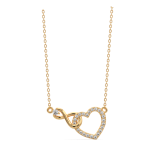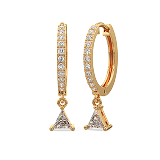Types of Gold: The Best Gold for Your Jewellery
Gold has always been a symbol of wealth, beauty, and sophistication. Whether you’re buying your first necklace or adding to your collection, knowing the different types of gold is essential.
In this post, we’ll explore gold by purity, colour, and finish, plus introduce you to KYMEE’s stunning 18k Gold Vermeil Jewellery for women, a collection that blends timeless elegance with modern affordability.
Understanding Gold and Its Timeless Appeal
Gold is more than just a metal; it’s a cultural icon. Across civilisations, it has been worn by royalty, celebrated in weddings, and treasured as a family heirloom.
The History of Gold in Jewellery
Gold jewellery dates back over 6,000 years. Ancient Egyptians believed it symbolised eternal life, while Romans used it as currency and status markers.
Why Gold Remains a Global Status Symbol
Gold never tarnishes, its colour doesn’t fade, and it’s universally recognised as valuable. Whether 24K or gold vermeil, its appeal is timeless.
Different Types of Gold by Purity
Gold purity is measured in Karats (K); the higher the number, the purer the gold.
24K Gold – Pure, Soft, and Luxurious
- Composition: 99.9% pure gold
- Pros: Rich, bright yellow; hypoallergenic
- Cons: Very soft and prone to scratching
- Best for: Collectors, ceremonial jewellery
22K Gold – Rich in Purity, Slightly Stronger
- Composition: 91.6% gold + alloy metals
- Pros: Lustrous, high value
- Cons: Still relatively soft
- Best for: Traditional wedding jewellery
18K Gold – The Perfect Balance of Luxury and Durability
- Composition: 75% gold + 25% alloys
- Pros: Durable, rich colour, fine jewellery standard
- Cons: Slightly softer than 14K
- Best for: Engagement rings, luxury jewellery
14K Gold – Affordable and Strong
- Composition: 58.3% gold
- Pros: Excellent durability, lower cost
- Cons: Less gold content
- Best for: Everyday wear
10K Gold – Everyday Durability
- Composition: 41.7% gold
- Pros: Very strong and affordable
- Cons: Less rich colour, may cause skin reactions
- Best for: Casual wear
Gold Types by Colour
Yellow Gold – The Classic Choice
The most traditional gold colour, perfect for warm skin tones.
White Gold – Modern and Elegant
Created by alloying gold with palladium or nickel, then rhodium-plated for a bright finish.
Rose Gold – Romantic and Unique
Blended with copper to achieve a soft pink hue.
Green Gold – Rare and Distinctive
A mix of gold and silver, giving a subtle greenish tint.
Based on Form or State
| Form | Use |
|---|---|
| Gold Bullion | Bars or ingots, used for investment |
| Gold Coins | Currency, collectables, investment |
| Gold Dust | Unrefined, from mining or panning |
| Gold Nuggets | Naturally occurring pieces |
| Gold Leaf | Thin sheets for decoration, art, and food |
| Gold Flakes | Small flakes, often decorative |
| Gold Powder | Industrial or scientific uses |
| Gold Foil | Similar to a leaf, slightly thicker |
Based on Usage / Industry Type
| Type | Context |
|---|---|
| Investment Gold | Bullion, coins, ETFs, etc. |
| Jewellery Gold | Alloys used in rings, necklaces, etc. |
| Dental Gold | Gold alloys for crowns and bridges |
| Electronic Gold | High conductivity, used in circuits |
| Medicinal Gold | Used in treatments, e.g., arthritis |
| Edible Gold | Food-grade gold (E175), gold leaf |
| Industrial Gold | Catalysts, connectors, plating |
Types of Gold by Plating
| Type | Thickness | Durability | Common Use | Notes |
|---|---|---|---|---|
| Flash Plating | < 0.175 microns | Very low | Costume jewellery | Cheap, wears quickly |
| Electroplating | 0.5–2.5 microns | Medium | Jewellery, electronics | Standard gold plating |
| Heavy Electroplating | 2.5+ microns | High | High-end jewellery | Longer-lasting |
| Vermeil | ≥ 2.5 microns | High | Fine jewellery | Gold over sterling silver |
| Gold-Filled | Not plated | Very high | Mid-range jewellery | Mechanically bonded gold |
| PVD Coating | Varies | Very high | Watches, electronics | Premium, scratch-resistant |
KYMEE’s 18K Gold Vermeil Jewellery Collection
KYMEE has perfected the art of making women’s jewellery that looks and feels luxurious while remaining budget-friendly.
Craftsmanship and Design Philosophy
Every KYMEE piece is crafted with precision, using thick 18K gold vermeil over sterling silver for a lasting shine.
How KYMEE Combines Beauty and Affordability
By choosing vermeil, KYMEE offers pieces that rival solid gold jewellery in appearance but are far more accessible in price.
Top Picks from KYMEE’s Collection for Women
- Minimalist Gold Hoops – Perfect for everyday wear
- Elegant Pendant Necklaces – Add sophistication to any outfit
- Stackable Rings – Ideal for creating a personalised look
How to Choose the Right Type of Gold for You
Considering Skin Tone and Style
- Warm skin tones: Yellow or rose gold
- Cool skin tones: White gold or vermeil
Balancing Budget and Quality
Vermeil offers a smart compromise between beauty and cost.
Longevity and Care
Higher karats look richer but require gentler handling; vermeil gives you longevity without excessive maintenance.
Caring for Your Gold Jewellery
Cleaning Tips for Different Types of Gold
- Use mild soap and warm water
- Avoid abrasive cleaners
Storing Your Jewellery Safely
- Keep in a soft pouch or lined box
- Store separately to avoid scratches
Conclusion
From pure 24K to versatile vermeil, gold comes in many forms to suit every budget, style, and occasion. If you’re looking for affordable luxury, KYMEE’s 18K Gold Vermeil Jewellery for women blends timeless elegance with everyday practicality, making it the perfect choice for modern women who want to shine without compromise.
FAQs
1. How many types of gold are there?
Gold is mainly classified by karat (purity) and colour.
By karat: Common types are 24K, 22K, 18K, 14K, 10K.
By colour: Yellow, White, Rose, Green, etc.
2. Which is better, 24K or 18K gold?
24K is purer (99.9%) but softer.
18K is more durable and better for jewellery.
3. What are the five types of gold?
Five common types:
- 24K – Pure gold
- 22K – 91.6% gold
- 18K – 75% gold
- 14K – 58.5% gold
- 10K – 41.7% gold
4. Is 916 gold 22K or 24K?
916 gold is 22K (91.6% pure gold).
5. Which karat gold is best?
Depends on use:
- 24K for investment
- 22K/18K for jewellery (stronger)
6. What is hallmark gold?
It’s gold certified for purity by an official agency (like BIS in India).
7. What is 914 gold?
Usually a mistake or typo for 916 gold (22K).
8. How to identify gold?
- Look for a hallmark stamp (like 916, 750)
- Test with a magnet (real gold is not magnetic)
- Get it checked at a jeweller
9. What does 375 mean on gold?
It means 9K gold (37.5% pure gold).
10. How to calculate the gold price?
- Find the current gold rate per gram.
- Multiply by weight in grams.
- Adjust for purity (e.g. 22K = 91.6%).
- Add making charges + GST (for jewellery).
11. Which gold type lasts the longest?
Solid gold lasts indefinitely, but vermeil is an excellent long-term choice for affordability and durability.
12. Is 18K gold vermeil good for sensitive skin?
Yes, vermeil is hypoallergenic as it’s made with sterling silver and thick gold.
13. How often should you clean your gold jewellery?
Every few weeks, for regular wearers, and less for occasional use.
14. Can vermeil be worn in the shower?
It’s best to remove vermeil before bathing to maintain its shine.
15. Why is KYMEE’s vermeil better than standard gold-plated jewellery?
KYMEE uses thick 18K vermeil over sterling silver, making it more durable and luxurious.
16. Is 24K gold better than 18K gold vermeil?
24K is purer, but vermeil offers beauty and strength at a lower cost.
 Best Seller
Best Seller
 New In
New In
 Necklaces
Necklaces
 Rings
Rings
 Bracelets
Bracelets
 Earrings
Earrings
 Personalized
Personalized
 Mangalsutra
Mangalsutra
 Vibe Combo
Vibe Combo




































